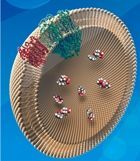Home > Press > Solar-powered nanofilters pump remove antibiotics to clean contaminated water
 |
| Using the mechanism bacteria use to shrug off powerful antibiotics, scientists have developed solar-powered nanofilters that remove antibiotics from lakes and rivers twice as efficiently as the best existing technology.
Credit:American Chemical Society |
Abstract:
Using the same devious mechanism that enables some bacteria to shrug off powerful antibiotics, scientists have developed solar-powered nanofilters that remove antibiotics from the water in lakes and rivers twice as efficiently as the best existing technology. Their report appears in ACS' journal Nano Letters.
Solar-powered nanofilters pump remove antibiotics to clean contaminated water
Washington, DC | Posted on May 1st, 2013David Wendell and Vikram Kapoor explain that antibiotics from toilets and other sources find their way into lakes and rivers, with traces appearing in 80 percent of waterways. Those antibiotics foster emergence of new antibiotic-resistant bacteria, while harming beneficial microbes in ways that can degrade aquatic environments and food chains. Filters containing activated carbon can remove antibiotics from effluent at municipal sewage treatment plants, before its release into waterways. But activated carbon is far from perfect. So the scientists looked for a better technology.
They describe development and successful laboratory testing of capsule-like "vesicles" containing the very mechanism that enables bacteria to survive doses of antibiotics. This system pumps antibiotics out of bacterial cells before any damage can occur. Wendell and Kapoor turned it around, however, so that the system pumps antibiotics into the vesicles. That way, they can be collected and recycled or shipped for disposal. In addition to the pump, the vesicles contain a propulsion system driven by sunlight. The pump system could be adapted to clean hormones, heavy metals and other undesirable materials from water, the scientists state.
####
About American Chemical Society (ACS)
The American Chemical Society is a nonprofit organization chartered by the U.S. Congress. With more than 163,000 members, ACS is the world's largest scientific society and a global leader in providing access to chemistry-related research through its multiple databases, peer-reviewed journals and scientific conferences. Its main offices are in Washington, D.C. and Columbus, Ohio.
To automatically receive news releases from the American Chemical Society contact
Follow us: Twitter Facebook
For more information, please click here
Contacts:
Michael Bernstein
202-872-6042
David Wendell, Ph.D.
School of Energy, Environmental, Biological and Medical Engineering
University of Cincinnati
2901 Woodside Drive
705 Engineering Research Center
Cincinnati, Ohio 45221
Copyright © American Chemical Society (ACS)
If you have a comment, please Contact us.Issuers of news releases, not 7th Wave, Inc. or Nanotechnology Now, are solely responsible for the accuracy of the content.
| Related Links |
| Related News Press |
News and information
![]() Researchers develop molecular qubits that communicate at telecom frequencies October 3rd, 2025
Researchers develop molecular qubits that communicate at telecom frequencies October 3rd, 2025
![]() Next-generation quantum communication October 3rd, 2025
Next-generation quantum communication October 3rd, 2025
![]() "Nanoreactor" cage uses visible light for catalytic and ultra-selective cross-cycloadditions October 3rd, 2025
"Nanoreactor" cage uses visible light for catalytic and ultra-selective cross-cycloadditions October 3rd, 2025
Discoveries
![]() Researchers develop molecular qubits that communicate at telecom frequencies October 3rd, 2025
Researchers develop molecular qubits that communicate at telecom frequencies October 3rd, 2025
![]() Next-generation quantum communication October 3rd, 2025
Next-generation quantum communication October 3rd, 2025
![]() "Nanoreactor" cage uses visible light for catalytic and ultra-selective cross-cycloadditions October 3rd, 2025
"Nanoreactor" cage uses visible light for catalytic and ultra-selective cross-cycloadditions October 3rd, 2025
Announcements
![]() Rice membrane extracts lithium from brines with greater speed, less waste October 3rd, 2025
Rice membrane extracts lithium from brines with greater speed, less waste October 3rd, 2025
![]() Researchers develop molecular qubits that communicate at telecom frequencies October 3rd, 2025
Researchers develop molecular qubits that communicate at telecom frequencies October 3rd, 2025
![]() Next-generation quantum communication October 3rd, 2025
Next-generation quantum communication October 3rd, 2025
![]() "Nanoreactor" cage uses visible light for catalytic and ultra-selective cross-cycloadditions October 3rd, 2025
"Nanoreactor" cage uses visible light for catalytic and ultra-selective cross-cycloadditions October 3rd, 2025
Interviews/Book Reviews/Essays/Reports/Podcasts/Journals/White papers/Posters
![]() Spinel-type sulfide semiconductors to operate the next-generation LEDs and solar cells For solar-cell absorbers and green-LED source October 3rd, 2025
Spinel-type sulfide semiconductors to operate the next-generation LEDs and solar cells For solar-cell absorbers and green-LED source October 3rd, 2025
![]() Rice membrane extracts lithium from brines with greater speed, less waste October 3rd, 2025
Rice membrane extracts lithium from brines with greater speed, less waste October 3rd, 2025
Water
![]() Taking salt out of the water equation October 7th, 2022
Taking salt out of the water equation October 7th, 2022
Alliances/Trade associations/Partnerships/Distributorships
![]() Chicago Quantum Exchange welcomes six new partners highlighting quantum technology solutions, from Chicago and beyond September 23rd, 2022
Chicago Quantum Exchange welcomes six new partners highlighting quantum technology solutions, from Chicago and beyond September 23rd, 2022
![]() University of Illinois Chicago joins Brookhaven Lab's Quantum Center June 10th, 2022
University of Illinois Chicago joins Brookhaven Lab's Quantum Center June 10th, 2022
|
|
||
|
|
||
| The latest news from around the world, FREE | ||
|
|
||
|
|
||
| Premium Products | ||
|
|
||
|
Only the news you want to read!
Learn More |
||
|
|
||
|
Full-service, expert consulting
Learn More |
||
|
|
||








